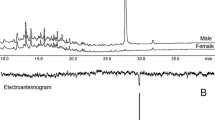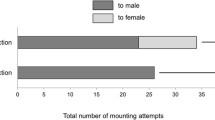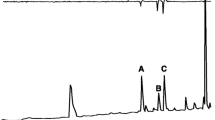Abstract
Male-released semiochemicals of the stink bug Piezodorus hybneri (Heteroptera: Pentatomidae) elicit attraction of male and female bugs and homosexual behavior in males. Three active components were isolated from the airborne volatiles of males by flash chromatography, with the activity monitored by GC-EAD and behavioral bioassay. The pheromone system was characterized as a mixture of β-sesquiphellandrene, (R)-15-hexadecanolide, and methyl 8-(Z)-hexadecenoate (ratio: 10:4:1), and the activity of the semiochemicals was assessed with authentic samples. Enantiomerically pure samples of the R and S macrolactones were obtained by Yamaguchi's and Mitsunobu's macrolactonization of a key intermediate, (R)-15-hydroxyhexadecanoic acid. The nonnatural S stereoisomer was neither a beneficial nor a behavioral antagonist. Individual constituents or binary mixtures were active, but the optimal male response was elicited only by the full mixture. Behavioral observation and the fact that the onset of pheromone production is coincident with ovarian development strongly suggest that these semiochemicals are, in fact, sex pheromones.
Similar content being viewed by others
REFERENCES
Aldrich, J. R., Kochansky, J. P., and Abrams, C. B. 1984. Attractant for a beneficial insect and its parasitoids: Pheromone of the predatory spined soldier bug, Podisus maculiventris (Hemiptera: Pentatomidae). Environ. Entomol. 13:1031-1036.
Aldrich, J. R., Hoffmann, M. P., Kochansky, J. P., Lusby, W. R., Eger, J. E., and Payne, J. A. 1991. Identification and attractiveness of a major pheromone component for Nearctic Euschistus spp. stink bugs (Heteroptera: Pentatomidae). Environ. Entomol. 20:477-483.
Aldrich, J. R., Oliver, J. E., Lusby, W. R., Kochansky, J. P., and Borges, M. 1994. Identification of male-specific volatiles from Nearctic and Neotropical stink bugs (Heteroptera: Pentatomidae). J. Chem. Ecol. 20:1103-1111.
Baker, R., Borges, M., Cooke, N. G., and Herbert, R. H. 1987. Identification and synthesis of (Z)-(1′S,3′R,4′S)-(−)-2-(3′,4′-epoxy-4′-methylcyclohexyl)-6-methylhepta-2,5-dione, the sex pheromone of the southern green stinkbug, Nezara viridula (L.). J. Chem. Soc. Chem. Commun. 1987:414-416.
Borden, J. H. 1985. Aggregation pheromones, pp. 257-285, in G. A. Kerkut and L. A. Gilbert (eds.). Comprehensive Insect Physiology, Biochemistry and Pharmacology, Pergamon Press, Oxford.
CardÉ, R. T., and Baker, T. C. 1984. Sexual communication with pheromones, pp. 355-383, in W. J. Bell and R. T. Cardé (eds.). Chemical Ecology of Insects, Chapman and Hall, New York.
Connell, D. W., and Sutherland, M. D. 1966. Terpenoid chemistry. XI. (−)-β-Sesquiphellandrene. Aust. J. Chem. 19:283-288.
Dawson, M. I., and Vasser, M. 1977. Synthesis of prostaglandin synthetase analogues. 1. (Z)-14-Hydroxy-12,13-methano-8-nonadecenoic acid. J. Org. Chem. 42:2783-2785.
Eisner, T., and Kafatos, F. C. 1962. Defense mechanisms of arthropods. X. A pheromone promoting aggregation in an aposematic distasteful insect. Psyche 69:53-61.
Higuchi, H. 1996. Male-attraction in Piezodorus hybneri. Proceedings, 40th Annual Meeting of the Society of Applied Entomology and Zoology of Japan, p. 119 (in Japanese).
Inanaga, J., Hirata, K., Saeki, H., Katsuki, T., and Yamaguchi, M. 1979. A rapid esterification by means of mixed anhydride and its application to large-ring lactonization. Bull. Chem. Soc. Jpn. 52:1989-1993.
Kaiser, von R., and Lamparsky, D. 1978. Neue macrolide und einige Sesquiterpen-Derivate aus dem Galbanum-Harz. Helv. Chim. Acta 61:2671-2680.
Kurihara, T., Nakajima, Y., and Mitsunobu, O. 1976. Synthesis of lactones and cycloalkanes. Cyclization of ω-hydroxy acids and ethyl α-cyano-ω-hydroxycarboxylates. Tetrahedron Lett. 2455-2458.
Kuwahara, S., Tsuruta, T., Leal, W. S., and Kodama, O. 1998. Synthesis of both enantiomers of 15-hexadecanolide, a sex pheromone component of the stink bug, Piezodorus hybneri. Biosci. Biotechnol. Biochem. 62:1261-1263.
Leal, W. S., Higuchi, H., Mizutani, N., Nakamori, H., Kadosawa, T., and Ono, M. 1995. Multifunctional communication in Riptortus (Heteroptera: Alydidae): Conspecific nymphs and egg parasitoid Ooencyrtus nezarae use the same adult attractant pheromone as chemical cue. J. Chem. Ecol. 21:973-985.
Leal, W. S., Hasegawa, M., Sawada, M., Ono, M., and Tada, S. 1996a. Scarab beetle Anomala albopilosa albopilosa utilizes a more complex sex pheromone system than a similar species A. cuprea. J. Chem. Ecol. 22:2011-2020.
Leal, W. S., Kuwahara, S., Ono, M., and Sakae, K. 1996b. (R,Z)-7,15-Hexadecadien-4-olide, sex pheromone of the yellowish elongate chafer, Heptophylla picea. Bioorg. Med. Chem. 4:315-321.
Leal, W. S., Ueda, Y., and Ono, M. 1996c. Attractant pheromone for male rice bug, Leptocorisa chinensis: Semiochemicals produced by both male and female. J. Chem. Ecol. 22:1429-1437.
Oliver, J. E., Aldrich, J. R., Lusby, W. R., Waters, R. M., and James, D. G. 1992. A male-produced pheromone of the spined citrus bug. Tetrahedron Lett. 33:891-894.
Roelofs, W. L. 1995. The chemistry of sex attraction, pp. 103-117, in T. Eisner and J. Meinwald (eds.). Chemical Ecology: The Chemistry of Biotic Interaction. Natioal Academy Press, Washington, D.C.
Shi, X., Leal, W. S., and Meinwald, J. 1996. Assignment of absolute stereochemistry to an insect pheromone by chiral amplification. Bioorg. Med. Chem. 4:297-303.
Sugie, H., Yoshida, M., Kawasaki, K., Noguchi, H., Moriya, S., Takagi, K., Fukuda, H., Fujie, A., Yamanaka, M., Ohira, Y., Tutsumi, T., Tsuda, K., Fukumoto, K., Yamashita, M., and Suzuki, H. 1996. Identification of the aggregation pheromone of the brown-winged green bug, Plautia stali Scott (Heteroptera: Pentatomidae). Appl. Entomol. Zool. 31:427-431.
Thornhill, R., and Alcock, J. 1983. The Evolution of Insect Mating Systems, Harvard University Press, Cambridge, Massachusetts, pp. 145-181.
Author information
Authors and Affiliations
Rights and permissions
About this article
Cite this article
Leal, W.S., Kuwahara, S., Shi, X. et al. Male-Released Sex Pheromone of the Stink Bug Piezodorus hybneri . J Chem Ecol 24, 1817–1829 (1998). https://doi.org/10.1023/A:1022307600446
Issue Date:
DOI: https://doi.org/10.1023/A:1022307600446




